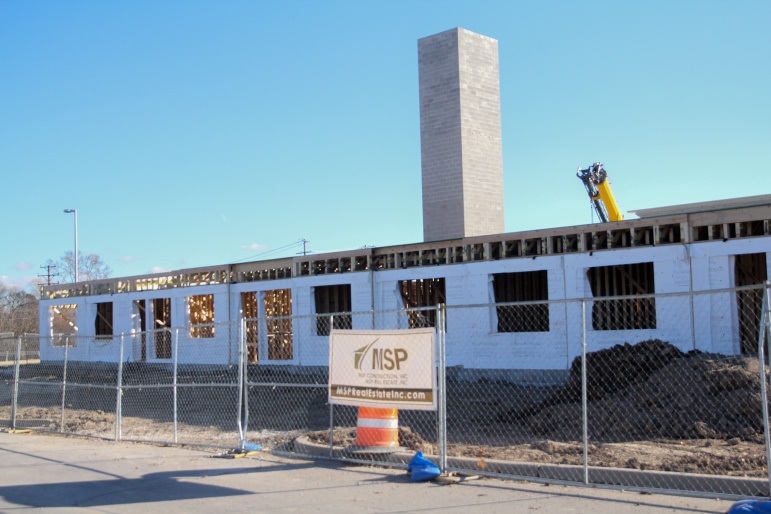Milwaukee County Is Funding Affordable Housing In Suburbs
Multi-year effort aims to address shortage, reduce disparities in communities that once opposed such housing.

MSP Real Estate, Inc. broke ground on its second affordable housing development in Wauwatosa, Wis. The construction site is shown on Sept. 1, 2023. The development is among those subsidized by Milwaukee County in an effort to boost affordable housing in Milwaukee’s suburbs. (Jonmaesha Beltran / Wisconsin Watch)
This story was originally published by Wisconsin Watch.
When Mark Hammond saw a vacant lot near the Mayfair Collection mixed-use community in Wauwatosa, Wisconsin, he knew he wanted to build an apartment complex.
The location checked all the boxes for desirable housing. It had access to transit, schools, parks, jobs, grocery stores and a medical center. Such a project could also chip away at a long-standing affordable housing shortage in Milwaukee County’s suburbs.
The result is an 80-unit housing development, with most units available to those earning up to 60% of the county’s median household income.
The project is one of MSP Real Estate’s 18 affordable housing developments statewide and its first project subsidized by Milwaukee County Executive David Crowley’s effort to expand housing options for lower-income workers in Milwaukee’s suburbs — the region’s largest affordable housing push in over 20 years.
Hammond said about $2.5 million in aid made the project possible during a time when financing workforce housing is particularly difficult.
“The financing that we got through the county really took a project that would not have been able to proceed — would really have had no chance in moving forward — and made the project feasible,” he said.
Municipalities statewide face an affordable housing crunch, but the Milwaukee metro region is home to a particularly big mismatch between jobs and workforce housing. Most job growth is happening in the suburbs, while affordable housing is largely concentrated in the city of Milwaukee’s historically disinvested neighborhoods, especially in Black and brown-majority communities.
For instance, 92% of Wauwatosa workers lived in another municipality when last measured in 2019.
“You don’t want people to come into your community, work and leave,” Crowley told Wisconsin Watch.
Crowley and his colleagues since 2022 have allocated more than $15 million to boost affordable housing in the suburbs — aiming to reduce barriers that prevent residents from living near work and seeking broader opportunities.
“You’re going to have to have affordable housing units in places outside of the city of Milwaukee,” Crowley said. “We can no longer continue to use affordable housing to concentrate poverty.”

Milwaukee County Executive David Crowley speaks about the county’s 2024 budget at Washington Park Senior Center in Milwaukee on Aug. 15, 2023. Crowley is working to expand housing options for lower-income workers in Milwaukee’s suburbs in the region’s largest affordable housing push in over 20 years. (Jonmaesha Beltran / Wisconsin Watch)
Milwaukee County officials hope the investment will incentivize affordable housing construction at a time when developers face worker shortages and rising costs due to inflation and interest rate hikes. But subsidies alone can’t fix the problem, experts say. Success would also require loosening restrictive municipal zoning policies that have narrowed space for development and reinforced the region’s stark racial segregation.
The Milwaukee-Waukesha-West Allis metro area ranks sixth nationally for restrictive zoning policies, according to an index developed by Princeton University’s Eviction Lab. Less than 2% of the region’s developable land is zoned for densities that could accommodate affordable housing.
But Hammond is optimistic about the region’s progress. He sees not-in-my-backyard sentiments easing in some communities.
“Since I started in this space I’ve noticed much more of an acknowledgment or an appreciation by most all communities of a need for affordable housing,” Hammond said.
Tight market prices out renters
About 70,000 Milwaukee County families earn $15 per hour or less, but the county has just 30,000 rental units considered affordable for them — those costing no more than $650 per month, according to a December 2022 county memo.
The 40,000-unit shortage for such lower-income families includes 7,000 suburban units, according to the memo.
That limits options for people earning higher incomes as well, including those living paycheck to paycheck but making too much to qualify for housing subsidies.
After moving out of his parents’ South Side Milwaukee home in 2020, 24-year-old Rogelio Balderas, who works in Wauwatosa for a real estate services company, said he found apartments ranging from $700 to $800 on Milwaukee’s Upper East Side. Now he struggles to find a similarly priced one-bedroom apartment, requiring him to increase his monthly budget to $1,100, nearly 40% of his income.
“There’s nothing available within a reasonable price range,” he said.

Robin Alexander, 27, works from home on Milwaukee’s East Side on Nov. 1, 2023. Alexander said he and his partner would consider moving to a suburb, but they can’t afford it even as they work multiple jobs. Alexander says he spends 40% of his income on rent, limiting his opportunities to buy a car. (Jonmaesha Beltran / Wisconsin Watch)
Affordable housing is generally defined as costing no more than 30% of a person’s income.
Robin Alexander, who lives on Milwaukee’s East Side, said he and his partner would consider moving to a suburb, but they can’t afford it. That’s even as he works two jobs — one full-time, one part-time — and his partner also works part-time. Alexander spends 40% of his income on rent, limiting his opportunities to buy a car.
“It’s just unaffordable kind of no matter where we are,” he said.
Shifting attention to Milwaukee’s suburbs
Milwaukee County now seeks to incentivize multi-family housing projects in communities that have traditionally put them off limits.
Developers tend to concentrate lower-income rentals in parts of Milwaukee’s central city, where they can snatch up cheaper land — away from amenities and centers of commerce, said Kori Schneider-Peragine, senior administrator of the Metropolitan Milwaukee Fair Housing Council.
That has widened a gap between economic opportunity and affordable housing.
“There’s obviously a need everywhere. But obviously the biggest needs are in places that have a lot of jobs. When people think about where we should put affordable housing, they tend to think, well, let’s put it in places where lower-income folks already live,” said Kurt Paulsen, an urban planning professor at the University of Wisconsin-Madison. “But there’s probably an abundance of housing already in those neighborhoods.”

Foxbrook Senior Apartments, seen on Aug. 1, 2023, is one of two affordable housing developments in Brookfield, Wis., available for people with low incomes, according to a federal Department of Housing and Urban Development resource locator. Both developments serve seniors. (Jonmaesha Beltran / Wisconsin Watch)
In 2022 the county set aside $15 million in federal American Rescue Plan funds to help finance projects in suburban communities. The county’s request for proposals to build multi-family properties ends Dec. 31.
The county additionally allocated $4 million for county-wide affordable housing projects in its 2024 budget.
It has thus far spent $9 million to collectively add 211 affordable units in Brown Deer, Wauwatosa and South Milwaukee, where new business occupancies have increased 525% over the last six years. A senior apartment complex is additionally slated to break ground in Greenfield.
The county could help finance three additional projects in Whitefish Bay, Brown Deer and South Milwaukee, adding 133 affordable units.
“In many of our suburban locations, it’s a new day, and they are welcoming these projects,” said Teig Whaley-Smith, chief alliance executive of Community Development Alliance, which has helped Milwaukee County craft its strategy for improving economic mobility.
Historic zoning laws crimp multifamily housing
But more is needed to propel affordable housing projects to the finish line. Nearly every county-funded project has also required some sort of local zoning change, Whaley-Smith added.
Wauwatosa — historically home to restrictive zoning laws — is exploring ways to unlock more land for affordable housing.
For decades until the 1960s, signs at Wauwatosa’s city limits signaled that not all were welcome:
“ENTERING WAUWATOSA
CITY OF HOMES
RESTRICTIVE ZONING.”
But in 2021 the city launched the “Zone Tosa for All” project to reassess zoning regulations and other policies to boost housing options and eliminate discriminatory barriers. More work is needed to understand the project’s results, Alderperson Margaret Arney said.
Zoning regulations in the United States date back to the 19th century and originally stemmed from concerns about fire hazards and light and air pollution. They run the gamut from restrictions on lot sizes and building height to prohibitions of multi-family homes.
A major reason American suburbs originally incorporated was to gain zoning power and to exclude apartments, Paulsen said.
“It’s a complicated and racist history,” he said. “It was when you allow a municipality to choose its own zoning without a sense of the greater regional need, of course, majority-white homeowners in suburbs are going to zone out any apartments whatsoever.”
That has unfolded in River Hills, a mostly white Milwaukee County village of 1,600. It has allowed only single-family homes, mostly on multi-acre lots, since its incorporation in 1930.
River Hills lacks any affordable housing options, a federal Department of Housing and Urban Development (HUD) resource locator shows. Years after rejecting a plan that initially included apartments, senior housing, duplexes and single-family homes for more than 500 people, the village in 2020 settled a lawsuit that alleged violations of the federal Fair Housing Act and the state’s “Smart Growth” law.

The Landmark of West Allis, a multi-family housing development for people 62 years and older, is seen in West Allis, Wis., on Aug. 1, 2023. Senior housing projects typically draw applicants from a smaller geographic radius than family housing, potentially making them more palatable in white-majority communities less likely to support rental housing, said Kori Schneider-Peragine, senior administrator of the Metropolitan Milwaukee Fair Housing Council. (Jonmaesha Beltran / Wisconsin Watch)
Just west in Waukesha County, single-family homes account for nearly 70% of housing units. Developers over the past 11 years have built only three affordable housing projects targeting low-income households, according to a Wisconsin Policy Forum report. That’s compared to 71 such developments in Milwaukee County.
In one of the state’s priciest housing markets, Waukesha County has just one housing unit for every 1.37 jobs — far above the state average.
Not everyone agrees on the need to welcome lower-income workers.
“We don’t step down to allow the people who can’t afford to live in Brookfield to come in because then we become West Allis and we become Wauwatosa,” Brookfield Alderman Kris Seals said in January 2023, drawing a mix of condemnation and support as the city council discussed an apartment project that would offer reduced rents to lower-income families.
He added: “If you can’t afford those units, then you live in Wauwatosa or West Allis until you can afford to move into Brookfield.”
The federal resource locator shows just two Brookfield properties available for people with low incomes, and they both serve seniors.
Senior housing projects typically draw applicants from a smaller geographic radius than family housing, potentially making them more palatable in white-majority communities less likely to welcome people of color, Schneider-Peragine said.
Should the state intervene?
Although the Wisconsin Legislature has limited local control on other housing issues, lawmakers have traditionally refrained from meddling in local decisions concerning land use and zoning.
Some housing advocates say state legislation may be necessary to open up more housing opportunities for low-income residents. Community Advocates, a Milwaukee-based social service nonprofit, calls for setting aside more tax credits to incentivize multifamily developments and requiring local governments to end exclusionary zoning laws.
The League of Wisconsin Municipalities, which advocates on behalf of Wisconsin’s local governments, launched a “cookbook” in 2022 that suggested local zoning changes that could cut construction costs and add options for low-income and moderate-income families through denser development.
“The state Legislature passing a mandate that says build more workforce housing units would be kind of a meaningless mandate without the resources to do that,” said Jerry Deschane, executive director of the League of Wisconsin Municipalities.
Some lawmakers say mandates could be a last resort to free up land for affordable housing.
“We’re going to provide some carrot with some compliance, and if the communities don’t step up, then our only alternative is mandates like a lot of other states have had to turn to,” Rep. Robert Brooks, R-Saukville, said during a joint informational hearing on Wisconsin’s housing shortage in March.
For now, Crowley hopes the county’s growing existing partnerships in Wauwatosa, Brown Deer, South Milwaukee and Greenfield will spur others to aid the cause.
“If we’re going to look to the future and see how we can do more of these developments, we’re going to need partnerships with banks,” he said. “We’re going to need partnerships with developers, with the state, with the federal government because we’re going to have to leverage all of our resources because of how expensive it’s become to create these types of projects.”
PrincessSafiya Byers of Milwaukee Neighborhood News Service contributed to this report.
The nonprofit Wisconsin Watch (www.WisconsinWatch.org) collaborates with Milwaukee Neighborhood News Service, WPR, PBS Wisconsin, other news media and the University of Wisconsin-Madison School of Journalism and Mass Communication. All works created, published, posted or disseminated by Wisconsin Watch do not necessarily reflect the views or opinions of UW-Madison or any of its affiliates.
Political Contributions Tracker
Displaying political contributions between people mentioned in this story. Learn more.
-
Legislators Agree on Postpartum Medicaid Expansion
 Jan 22nd, 2025 by Hallie Claflin
Jan 22nd, 2025 by Hallie Claflin
-
Inferior Care Feared As Counties Privatize Nursing Homes
 Dec 15th, 2024 by Addie Costello
Dec 15th, 2024 by Addie Costello
-
Wisconsin Lacks Clear System for Tracking Police Caught Lying
 May 9th, 2024 by Jacob Resneck
May 9th, 2024 by Jacob Resneck





















More social engineering with your tax dollars. This is not something government should be doing. Playing Santa Claus with our money. People struggling to get by are funding cheap housing for people who just want freebies handed to them.